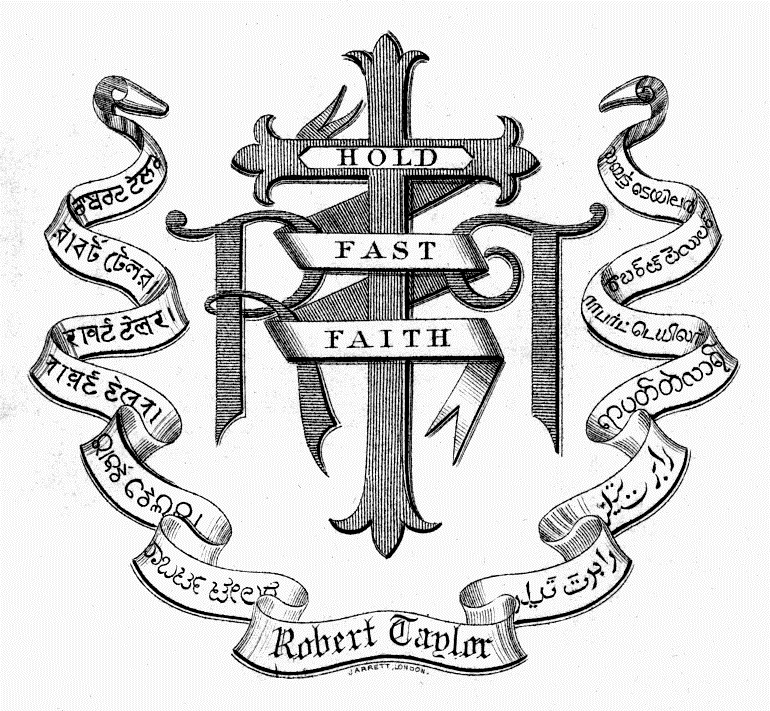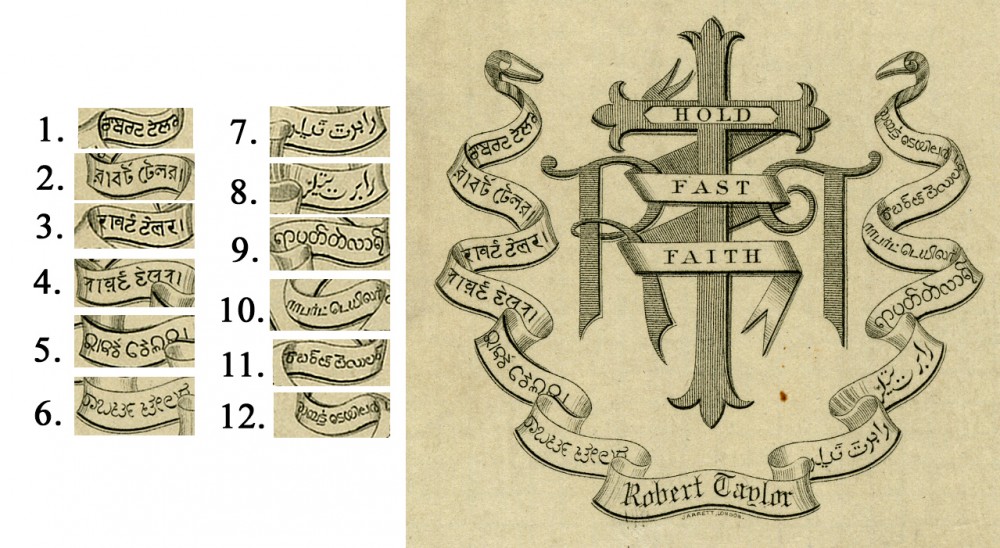Provenance made (almost) perfect
We recently received an intriguing enquiry from Anthony Pincott, Treasurer & Membership Secretary of The Bookplate Society (www.bookplatesociety.org). In the course of indexing recent issues of The Bookplate Journal, he sought to identify the owner of the following bookplate:

This bookplate is signed by a London engraver, B. Jarrett , who was active in the 1830s and 1840s, and its owner is suspected to be the Colonel Robert Taylor (1788-1852) who in 1803 was sent to the Middle East as an army cadet and became an Oriental scholar and the British Resident in Basra and Baghdad, where he was the predecessor of Sir Henry Creswicke Rawlinson, decipherer of Cuneiform.
The bookplate clearly indicates the owner’s interest in, and implicit command of, a dozen Asian languages, most of which are well-known but a few are comparatively obscure. The British Library has a large collection of Arabic manuscripts collected by Robert Taylor, and conservator Flavio Marzo wrote a fascinating blog about them in 2014: http://britishlibrary.typepad.co.uk/collectioncare/2014/06/a-book-binder-for-mr-taylor.html
Col. Robert Taylor is also associated with an object referred to as the “Taylor prism”, or Sennacherib Prism, Library of Ashurbanipal. The cuneiform inscriptions on this hexagonal clay tablet list the campaigns of Sennacherib until the start of his final war against Babylon, and includes a description of the tribute received from Hezekiah, King of Judah in 701 BC: see www.britishmuseum.org/research/collection_online/collection_object_details.aspx?objectId=295077&partId=1. Taylor is said to have purchased the prism in 1830; it was sold by his widow to Rawlinson in 1855, and it entered the collection of the British Museum the same year.
Unfortunately, the RAS library does not appear to contain any objects, books or manuscripts from Taylor’s collection, nor seemingly any specimens of the bookplate which might confirm it was clearly his. Indeed, perhaps surprisingly, Taylor does not appear to have ever joined the Royal Asiatic Society of Great Britain and Ireland, although he did support the Oriental Translation Committee, which was an affiliated organization dedicated to publishing translations of classical works of Asian cultures.
But although we haven’t been able to confirm the ownership of the bookplate, we were able to establish what languages it depicts. While some of the scripts are easy to identify, some are rarely seen by most people in Great Britain today. The number of people who can read them all is probably quite low – although presumably Robert Taylor could. We took to Twitter and asked our followers to help crowdsource the desired information, working from the following graphic, presenting the texts from the bookplate in more convenient form:

The result was impressive! We received a wonderfully enthusiastic and helpful response from lots of people from all over the world – and particularly from South Asia and the UK – helping to identify the different languages. While some of the scripts are widely used around the world (such as Devanagari and Arabic), others are much less familiar to contemporary audiences, such as Kaithi. Kaithi is a historical script that was used for administrative purposes in parts of North India; although it has been superseded by other scripts such as Devanagari, in the nineteenth century the British authorities recognized it as an official script for legal purposes, and so it would have been relatively familiar to colonial administrators like Taylor. (Thanks to RAS Council member Jim Mallinson for identifying this particular script!)
We are extremely grateful to everyone who helped us to identify the scripts on the bookplate. The consensus that emerged on Twitter identified them as follows:
1=Gurumukhi, 2=Bengali, 3=Devanagari, 4=Kaithi, 5=Odia, 6=Kannada, 7=Arabic, 8=Persian, 9=Burmese, 10=Tamil, 11=Telugu, 12=Malayalam
Of course, the thirteenth language depicted on the bookplate is English. Therefore, the bookplate provides thirteen different renderings of “Robert Taylor”. Its owner, Col. Robert Taylor is said to have been highly proficient in Arabic and Persian (helping to explain his professional success), but – if it is indeed his – the bookplate suggests he had at least some knowledge of a variety of Indian and other languages as well; or he wanted to give that impression.
A raft of material sheds light on the fascinating life of Col. Robert Taylor (although he gets no entry in the Oxford Dictionary of National Biography) and it’s a sign of the importance of book history in helping to explain the past. The surviving biographical material suggests Taylor spent four decades in Asia between 1803 and 1843. At a young age he married an Armenian woman named Rose (or Rosa), elder daughter of Ovanness Moscow from Shiraz in Iran. Along with their oldest son, Rose was kidnapped by pirates in ca. 1808, but was ransomed and reunited with her husband shortly after, eventually surviving him by several years.
Hopefully a future entry in The Bookplate Journal will bring this material together and help provide a new reference point for people interested in researching this important period of history. We are very grateful to Anthony Pincott for bringing the bookplate to our attention and for introducing us to this fascinating story. If any of our readers know of more examples of this bookplate, please let us know, or contact him at membersATbookplatesocietyDOTorg (but use symbols for AT and DOT). What still awaits discovery is the “missing link”, namely a book or manuscript bearing both the bookplate and an inscription that proves conclusively that Colonel Taylor was the owner of both.
With thanks to Anthony Pincott for his assistance with this blog post.
